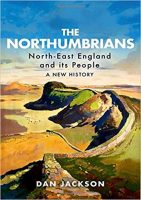The Northumbrians: North-East England and Its People
by Dan Jackson
(Hurst, £20)
 While I was reading The Northumbrians, an exhibition opened at the Bowes Museum in Barnard Castle in County Durham, and the BBC sought a comment on the artist from Professor Jean Brown, director of Northumbria University Art Gallery. Here, she said, was a man of “phenomenal talent”, whose drawings could bear comparison with those of Rembrandt, Degas, Lautrec — “that’s the standard of work”.
While I was reading The Northumbrians, an exhibition opened at the Bowes Museum in Barnard Castle in County Durham, and the BBC sought a comment on the artist from Professor Jean Brown, director of Northumbria University Art Gallery. Here, she said, was a man of “phenomenal talent”, whose drawings could bear comparison with those of Rembrandt, Degas, Lautrec — “that’s the standard of work”.
It is not a comparison the artist heard often. He was Norman Cornish (1919-2014), a miner who never went to art school, and who throughout his life was overlooked and under-valued. He suffered, he reckoned, from the proposition that “a man who works in a mine is not up to writing or painting or playing music. But it simply isn’t true.”
As with the artist, so with the area that produced him. The North East of England, Dan Jackson argues, is a place “whose story has been misunderstood and its people underestimated”. In The Northumbrians, which takes us from the building of Hadrian’s Wall to the vote on Brexit, through the heyday of coal to the fitting of solar panels on homes for retired miners, he sets out to put that right. His story is both an education and an entertainment.
I haven’t been to the North East — yet: I have a niece who is due to marry in Riding Mill in March. But even before reading The Northumbrians I knew of its reputation for friendliness and football-craziness, for hard work and heavy drinking; for producing men who took up arms as readily as they went down pits. I’ve now got a better understanding of why place and people are the way they are — and a rich source of material for quizzes.
As a small child in Northern Ireland, I often heard my elders sing that “Bobby Shafto’s gone to sea,/Silver buckles at his knee…” I never asked who he was. Bobby Shafto (1732-1797), I learn, was “a bountiful County Durham MP”. Maybe this “dandling song” was borne back home by Irish migrants, who, Jackson tells me, were a huge part of the workforce of the North East in the 19th century.
Having long been familiar with the railway pioneer George Stephenson (who was born in Wylam and initially followed his father down the pit), I’ve now made the acquaintance of the Newcastle-born William Armstrong, solicitor turned inventor. Between 1868 and 1927, his company produced 42 per cent of British warships, a fact of which the locals might have reminded you over a pint in his fiefdom of Scotswood — in The Gun, or The Rifle, or The Ordnance Arms.
I now know, too, that the first stained glass seen in England was made in the 7th century in Jarrow; that the first house in the world to be lit by electricity was in Gateshead, that John Walker invented the safety match at Stockton-on-Tees; and that the Mason-Dixon line in the United States was drawn by Jeremiah Dixon, an astronomer and surveyor from County Durham. There has been a thirst in Northumbria not only for drink but for knowledge: a shipbuilder was fond of quoting Virgil and a miner was known as “Two Williams” because he would recite Blake or Wordsworth at the coalface.
Dan Jackson, who was born on the banks of the Tyne, is devoted to his place and people, but not blind to their faults. He admits that Northumbrians are prone to sentimentality, that there’s suspicion of individualism, and that the community spirit can sometimes turn suffocating and racist.
He acknowledges, too, that the contribution of women has often been overlooked and that even today’s high-tech industries are male-dominated. He pays tribute to Northumbrian women as various as Mary Astell (1666-1731), “possibly Britain’s earliest feminist thinker”, Ada Lovelace, “now widely regarded as the world’s first computer programmer”, and Susan Auld, who designed the landing craft used on D-Day. Shame, then, that in a passage on the post-industrial landscape he writes of a spine of pit heaps: “I recommend ‘bagging’ them, much as Scotsmen do with Munros…”
His own patch isn’t always as singular as he thinks. He writes of a festival on New Year’s Eve in the village of Allendale in the North Pennines in which men run through the streets with barrels of burning tar on their heads. Does such “distinctive Northumbriana live on outside of the moors of Hexhamshire?” he asks. Well, every November 5, the men of Ottery St Mary in east Devon run through their streets with what their website says are “full-sized” flaming tar barrels on their shoulders.
I’m surprised that no one at Jackson’s publisher knew about Ottery. I’m surprised, too, that though the book has photographs and illustrations, there’s no readable map of the region as a whole, which would have helped this prospective visitor. Text editing has been sloppy, with clichés (twice there’s “an embarrassment of riches”) and literals slipping through and punctuation marks left out. Still, when my niece’s wedding comes around, I’m looking forward to being the best-briefed newbie in the North East. MK
This review appeared in print in The Daily Telegraph on January 4, 2020 and is also online
